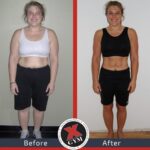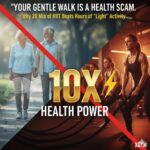 Less than 25% of Americans over the age of 45 participate in resistance training, but that’s the population who needs it the most!
Less than 25% of Americans over the age of 45 participate in resistance training, but that’s the population who needs it the most!
Research has shown that strength training with weights – especially high-intensity style like X Gym – is a virtual fountain of youth for people past 40 years old, who are at risk for losing muscle, declining hormone levels and other age-related factors that can be prevented instead of just accepted as part of the “normal” life cycle.
Besides the known benefits of preventing age-related muscle loss with strength training, researchers also found that weight lifting seniors enjoy a higher quality of life, improved cognitive function, better memory and emotional health, dementia prevention (and even reversal), increased bone density, energy levels, vigor, and the list goes on and on.
Health is not just the absence of illness. It also involves the quality of life where you can enjoy activities that require certain levels of exertion and fitness, like hiking with your friends, playing with your kids and grandkids, and specific instances like this recent email I just got from an X Gym member: “I just got back from a college reunion in Costa Rica. Several of my friends are lifelong athletes (some physician athletes). Even though I haven’t owned a bike in years, I was able to keep up with no problem over rough terrain, steep hills, etc. No one passed me. In closing, I know I still look like a wispy teenage art student. Nonetheless, I am able to perform well physically even though I am now close to 60 and my health markers are great despite having to deal with cancer. It’s easy to find clothes because I am the same size as most mannequins. None of my friends or coworkers have bested my physically.”
That email story describes true, real health. Yes, being free from disease is a part of it, but as you can see, there are other parts that make life enjoyable and strength training is a necessary ingredient in achieving that goal. This isn’t just my opinion either, it’s irrefutable, based on all the research out there. The list below is less than .01% of the studies proving how vital strength training is to looking, feeling and acting young. It’s the closest thing we have to a fountain of youth!
- Mayo Clinic Proceedings, 2011; 86(9):876
- Chicago Tribune, May 7, 2015
- Preventing Chronic Disease, 2014;11:1400007
- WebMD, Sarcopenia with Aging
- Quality of Life Research November 9, 2017; doi:10.1007/s11136-017-1733-z
- University of Jyväskylä, November 20, 2017
- Medical News Today, November 24, 2017
- PsychCentral, Your Sense of Coherence
- Journal of Applied Physiology, 2012; 113(12): 1831
- University Health News Daily, September 14, 2017
- Arthritis Health, July 6, 2015
- Harvard Health Publishing, 5 Weight Training Tips for People with Arthritis
- Clinical Interventions in Aging, 2016; 11:749
- Frontiers in Psychology, 2014;5:753
- Marketing Charts, November 12, 2007
- American Family Physician, 2000;61(7):2173
- National Institute on Aging, Prevent Falls and Fractures
- Deutsches Arzteblatt International, 2011;108(21):359
- Journal of Gerontology, 2006; 63(1): 78
- Journal of Physical Therapy Science, 2013;25(12):1591
- Journal of Clinical and Diagnostic Research, 2014;8(3):98
- Centers for Disease Control and Prevention, Costs for Falls Among Older Adults
- Medicina, 2015;51(1):57
- University Herald December 30, 2013
- Journal of Neuroscience, 2016; 36(44): 11308-11319
- The New York Times April 18, 2012
- Journal of Experimental Psychology Jul 2014, 1142-1152
- New York Times April 30, 2014
- Medicinenet.com November 28, 2017
- Science Daily November 22, 2017
- MD Linx November 30, 2017
- Men’s Health November 14, 2017
- Journal of Cognitive Neuroscience November 2017; 29(11): 1895-1907
- Mercola.com March 12, 2017
- NeuroImage February 2018; 166: 230-238
- Science Daily November 13, 2017
- Nature Scientific Reports December 12, 2013: 3; 3457
- ABC News January 30
- J Gerontol A Biol Sci Med Sci (2006) 61 (11): 1166-1170
- Neurology October 23, 2012
- The Lancet, 2015; DOI: 10.1016/S0140-6736(15)60461-5
- Science Daily March 11, 2015
- Journal of Neurology, Neurosurgery and Psychiatry August 2011; 82(8):942-3
- The Journal of Neuroscience, 27 April 2005, 25(17): 4217-4221
- PLoS One 2009 Oct 20;4(10):e7506
- New York Times July 7, 2010
- The Journal of Neuroscience February 12, 2014
- The Journal of Neuroscience May 1, 2013; 33(18):7770-7
- Cell September 25, 2014: 15-(1); 33-45









